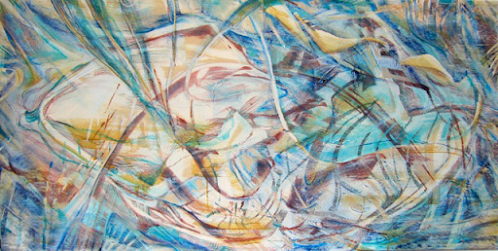kaidence green: The Surrealist Sketchbook
The Surrealist Sketchbook
In her latest exhibition, Nancy Newton navigates an oceanic dream-scape, drawing connections between the music of R. Murray Schafer’s Dream-e-scape and the other-worldly textures found in shells from the Mediterranean marine ecosystem. Before Nancy Newton started work on her latest visual collection, From The Sea / From The Past, she worked within her sketchbook, creating a series of drawings of shells found on her travels. The sketchbook is a site for growth, developing a routine sketchbook practice allows artists to play with materials and investigate new strategies within a low stakes, private environment. A catalogue of interpretive explorations and sketchbook studies is a crucial instrument in an artist's toolkit, allowing artists to experiment stylistically and materially.
Experimental sketchbook practice opens artists to new modes of thinking and generating. Inspired by Surrealist drawing techniques and Nancy Newton’s creative timeline for From The Sea / From The Past, which relied heavily on formative sketchbook work, the following three exercises not only facilitate further connection to Newton’s work through site-specificity, materiality, and kinesthetic learning, but provide new techniques for artistic production.
Before embarking on the following exercises, please take the time to investigate an aquatic site of your choosing, creating your own collection of found objects. Sensorially explore, selecting objects that creatively intrigue and delight. Note the tactile texture, the visual patterns and grooves, the sound generated, perhaps the smell or feeling the object elicits. These objects form the basis of later sketchbook pieces.
Note: these explorations and interventions into site must be performed responsibly, taking great care not to disturb or harm the environment.
Link to R. Murray Schafer's Dream-e-scape, which can be played while working on the sketchbook activities.
https://www.youtube.com/watch?v=iqASBnCN6RU
Exercise 1: Automatic Drawing
Set up your drawing materials in a site of your choosing (at home, in an accessible studio, in a public or natural space, perhaps in the environment where the found objects originated).
With headphones or without, queue R. Murray Schafer’s Dream-e-scape
On a large drawing surface, draw continuously without breaking concentration. You can listen to the entire piece – 20:30 – or break the work into 1-5 minute intervals. The goal is to establish a reactionary stream of consciousness, creating synchronously with the instrumentals.
Traditional automatic drawing emphasizes maintaining constant connection between drawing utensil and surface to create an unbroken line of action. This approach is optional, feel free to switch between drawing materials as desired.
Exercise 2: Meditative found object drawings
In a site of your choosing, select a variety of found objects and drawing materials and surfaces. This is an exercise in creative observation, reacting to the unique objects and extending your impression of them onto paper. You may listen to R. Murray Schafer’s Dream-e-scape, however this is not necessary.
Quiet your mind and connect to the objects. Take five deep breaths while using your senses to completely observe the objects.
On multiple medium drawing surfaces, draw what you see, smell, hear, and touch. Using a variety of mediums may allow you to express a broad range of reactions.
The goal is not to completely replicate the objects but to create brief renderings and observational sketches that connect the artist to the object.
Exercise 3: Frottage
A drawing technique developed by the surrealists to capture interesting textures from everyday objects. Using your drawing materials to physically record the objects enlists touch to heighten the connection to the site and materials.
Select a variety of objects from your collection, placing them on a flat surface. Place a piece of paper over the object then shade or rub your drawing utensil over the object to capture the texture. Repeat multiple times, using different objects.
Tips for picking up texture:
Use relatively flat objects and a thin piece of paper
Use dry media like graphite, charcoal, dry pastels, crayons, etc.
Shade lightly or rub the broad side of the drawing tool, using a “windshield wiper” motion; moving the drawing material back and forth over the object
Reflect on the collection of frottages, what did you capture? How did the materials surprise you?





